
The burial objects unearthed from the Tang tombs.
Gongyi in Zhengzhou, Henan Province boasts the largest number of tombs of the Tang Dynasty. The tomb owners were mostly wealthy people or lower-ranking officials. The number of burial objects unearthed from such a tomb is 20-50 pieces, in categories of sacred objects, servant figurines, household pieces and utensils. Sacred objects are placed near the tomb gate, to safeguard the tomb owner. Servant figurines are behind the sacred objects, to represent the scene when the tomb owner made a trip. Household pieces are near the eastern wall of the tomb chamber, to reproduce the real life the tomb owner had enjoyed. Utensils are near to the coffin, for the convenient use of the tomb owner.
What did tomb-guarding beasts disappear overnight after having been in existence for over 1,000 years? What could be the culture-related reasons behind this?
Your answer please, if you have any questions or answer, please feel free to send us email, we are waiting for your answers and participation, and your comments, answers and suggestions will be highly appreciated. We will select and publicize the most appropriate answers and comments some time in the future.
Weekly Selection Email: meizhouyipin@chnmus.net
Tomb-guarding beasts were in existence for over 1,300 years, during which period they experienced great changes: The media changed from wood and copper in the early stage to pottery and porcelain in the late period, with lacquer-painted and gold- and silver-inlaid ornaments on an early-stage piece to pigmented or tri-color glazed ones in later years. As for the posture, a tomb-guarding beast was usually a standing bird, beast or human being in the early stage, while in later years, it was made into a crouching lion- or human-faced one. People in ancient China made painstaking efforts in the creation of tomb-guarding beasts, demonstrating their zeal to and mental dependency on this type of mythical creatures.
The development of tomb-guarding beasts experienced four stages, namely the initial stage from the Spring and Autumn Period to the Warring States Period; the early stage during the State Wei period and the Jin Dynasty; the evolution stage in the Northern Dynasties and the Sui Dynasty; and the meridian stage in the Tang Dynasty. The development of tomb-guarding beasts saw a sharp decline since 770 A.D. Here are some archaeological evidences to it.
Three examples from the initial stage.
1. Human-shaped tomb-guarding beast unearthed from the Tomb of Duke of Zheng dating back to the mid-Spring and Autumn Period in Lijialou, Xinzheng, Henan Province: The seated beast has two coiling snakes tramped underneath each foot. Its belly protrudes and there are nipples on its chest. A big head is on the strong neck. It holds two curved poles in the mouth and other two extend behind its head, in the imitation of deer antlers. The tomb-guarding beast measures 47cm high, 34cm long and 30cm wide (Fig.5).
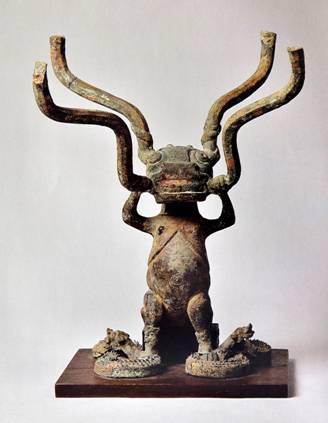
2. A wooden tomb-guarding beast unearthed from the Chu tomb in Tianxing Taoist Temple, Jiangling, Hubei Province: Two beasts sit back to back, looking outwards. The neck and the tail merge into one and stick into the square base. Each beast has deer antlers on the head and its long tongue sticks out. It is entirely coated with black lacquer, painted with beast-face, kui, cloud and diamond patterns in red, yellow and gold. The piece is 170cm high (Fig.6).
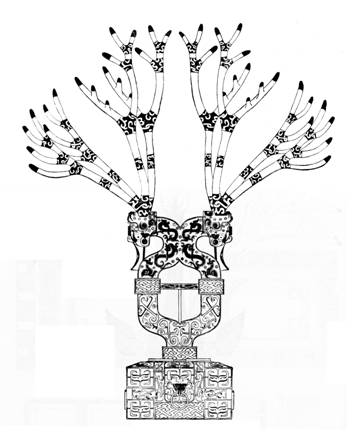
Fig.6 Wooden tomb-guarding beast unearthed from the Chu tomb in Tianxing Taoist Temple, Jiangling, Hubei Province
3. Silver-inlaid copper winged tomb-guarding beast unearthed from the tomb of King of Zhongshan kingdom in Pingshan, Hebei Province: The beast holds its head high, with mouth turning to the other side. Wings grow from under shoulders, and wide tails droops down. The beast half crouches, seem to be soaring to the sky. It is entirely inlaid with silver and magnificent-looking, thus is viewed as the most stunning example of the kind. It measures 40.1cm long and 23.9cm high (Fig.7).
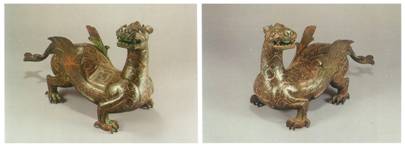
Fig.7 Two pairs of silver-inlaid copper winged tomb-guarding beast unearthed from the tomb of King of Zhongshan kingdom in Pingshan, Hebei Province
One example from the early stage.
The earthenware tomb-guarding beast unearthed from No.34 Tomb of the Western Jin Dynasty in Xingyuan, Yanshi, Henan Province: The bull-like beast looks like a dog at the head and tail. Three halberd-shape horns stick out at the neck, short wings grow out of the shoulders and feathers grow on its back. The strong beast is ferocious-looking and looks as if it is walking and seeking food. It measures 34.5cm long and 23.7cm high (Fig.8).
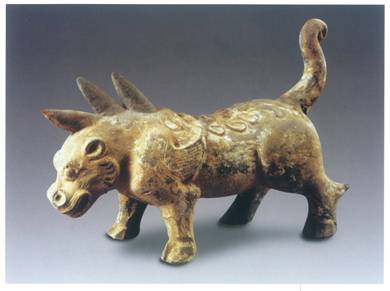
Fig.8 Earthenware tomb-guarding beast unearthed from No.34 Tomb of the Western Jin Dynasty in Xingyuan, Yanshi, Henan Province
Two examples from the evolution stage.
1. A pair of earthenware tomb-guarding beasts unearthed from Yuan Shao’s tomb of the Northern Wei Dynasty in Luoyang, Henan Province: Both the lion-faced and the human-faced tomb-guarding beasts hold their heads and chests high. Each has three groups of mane on the back. The short tail turns upwards. Feathered wings grow on its shoulders and long mane around the neck. Each beast seats on a rectangular board, the front legs straight. The 25.5cm-high lion-faced tomb-guarding beast opens its mouth wide and sticks its tongue out. The human-faced beast is also 25.5cm high. Short horned, it has protruding nose and mouth. From the Northern Wei Dynasty, the number of tomb-guarding beasts in a tomb increased from one to two, and stylized thereafter (Fig.9).
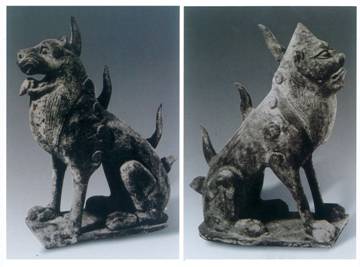
Fig.9 A pair of grey-pottery tomb-guarding beasts unearthed from Yuan Shao’s tomb of the Northern Wei Dynasty in Luoyang, Henan Province
2. A pair of porcelaneous tomb-guarding beasts unearthed from Zhang Sheng’s tomb of the Sui Dynasty in Anyang, Henan Province: Entirely coasted with glaze, each beast puffs up its chest and holds its head high. Halberd-shape ornaments turn upward behind its head. There are short manes on its back and feathers on the shoulders. With its front legs extend forward, a beast crouches on a rectangular base. The dragon-faced beast features a black snout, two curved horns. It opens its mouth wide and bares its teeth. This beast is 56cm high. The human-faced beast has a black horn on the crown. Its ears are protruding. The 50cm-high beast looks untamable with its nostrils and mouth to the sky (Fig.10).
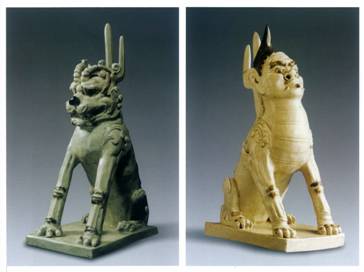
Fig.10 A pair of porcelaneous tomb-guarding beasts unearthed from Zhang Sheng’s tomb of the Sui Dynasty in Anyang, Henan Province
Three examples from the meridian stage.
1. A pair of pigmented pottery tomb-guarding beasts unearthed from M89 in Zhitian, Gongyi, Henan Province: Each beast holds its head high and has flame-shape wings on its shoulders. It crouches on a square base, with the front legs stretching straight. The lion-faced beast has three short horns on the crown, with bulging eyes, wide cheeks and a light-closed mouth. It measures 33.9cm high. The 35.4cm-high human-faced beast has a small curved horn on the crown, with a square jaw, high eyebrows, bulging eyes and wide cheeks. Both are coated with red and black. However, the paint has largely peeled off (Fig.11).
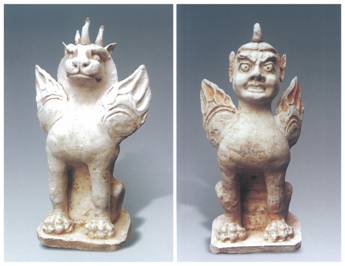
Fig.11 A pair of pigmented pottery tomb-guarding beasts unearthed from M89 in Zhitian, Gongyi, Henan Province
2. A pair of pigmented pottery tomb-guarding beasts unearthed from Gongyi Food Products Factory, Henan Province: The lion-faced beast has two straight horns on its crown. The halberd-shape ornament is wide and thick. Tooth-shape wings grow out of the beast’s shoulders. The 62.4cm-high beast crouches high on a pedestal, its mouth wide open and eyes bulging. It looks simply magnificent, despite the peeling paint. The human-faced beast has one wide and flat horn and three smaller horns on its crown. Its protruding ears are extraordinarily wide and its wings in the shape of palms. This beast takes a same posture as its counterpart does. This round-eyed high-nosed figurine looks much more powerful than the human-faced beasts before it. The beast measures 65.2cm high (Fig.12).
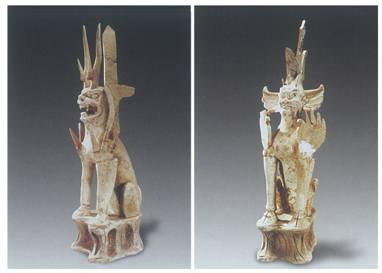
Fig.12 A pair of pigmented pottery tomb-guarding beasts unearthed from Gongyi Food Products Factory, Henan Province
3. A pair of tri-color glazed pottery tomb-guarding beasts unearthed from M38 in the Second Power Plant of Gongyi, Henan Province: Different from the aforementioned tomb-guarding beasts, these two both have halberd-shape ornaments in the shape of flame and are coated with yellow, white and green glaze. The fantastic-looking mixed glaze adds more power to these two majestic-looking beasts. The animal-faced beast measures 74.4cm high and the human-faced one 76cm high (Fig.13).
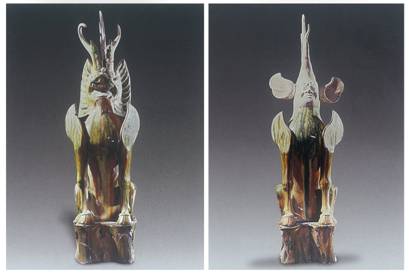
Fig.13 A pair of tri-color glazed pottery tomb-guarding beasts unearthed from M38 in the Second Power Plant of Gongyi, Henan Province
As the objects with distinctive characteristics in funeral and burial culture, tomb-guarding beasts well demonstrate the complicated feelings the living held toward the deceased. On the one hand, the living hoped that the deceased would be free from harms by evil spirits and ghosts. On the other hand, the living wished for a calm life without any disturbance from the deceased. Tomb-guarding beasts kept changing in shape and form, as the living held such complicated feelings. In the early days, people created tomb-guarding beasts in the shape of human being, tigers and deer, trying to ward off evil spirits and ghosts with the forms in real life. A tomb of the Wei and Jin dynasties was guarded by a single beast that had thorns on the neck and looked like a dog-bull creature. It was a new creation combining the ferocity of dogs and the strength of bulls. In the Northern Wei Dynasty, people began to place a pair of tomb-guarding beasts in a tomb. Such beasts got higher and larger in the Tang Dynasty, with more exaggerated ornaments, to strengthen the power of those beasts. However, the power of tomb-guarding beasts to ward off evil spirits and ghosts seemed to keep declining and they had to be removed from a tomb and replaced by figurines of 12 zodiac animals, gold bulls and iron pigs. Tomb-guarding objects then turned into a new system. But the reason for this change remains for discussion.
As indicated by the name, a tomb-guarding beast model was a sort of spell-casting object used to suppress the evil demons and guard the tomb owner. The spell-casting practice began to prevail in the Han Dynasty and was mentioned in Houhan Shu (The Book of the Later Han) and Jin Shu (The Book of the Jin Dynasty). Spell-casting objects were made of various materials, including wood, pottery, metal and stone, into different shapes, such as door-gods, peachwood charms, knives and swords, as well as iron plates. According to Datang Kaiyuanli (The Book of Rites of the Kaiyuan Era of the Tang Dynasty), four objects in a tomb were collectively known as the Four Deities. The four objects in Datang Liudian (Six Canons of the Tang Dynasty) were called dangkuang, dangye, zuming and dizhou, indicating that these four objects had been seen as gods by that time. What are they indeed? According to Wang Qufei’s investigation, these four objects are larger and higher than the other objects in a tomb. Dangkuang and dangye refer to the warrior figurines, while zuming and dizhou are two tomb-guarding beasts. As described in The Book of the Later Han: Records of Etiquette, the maids in the imperial palace of the Han Dynasty would wear masks in a ceremony for warding off evil spirits. There were 12 types of masks, all of which were decorated with hair and horns, to ward off evils. One of the 12 masks was called zuming. Wang Qufei thus held that the tomb-guarding beasts in the Tang tombs were actually “zuming” mentioned in The Book of the Later Han.
Two tomb-guarding beasts were unearthed in 1986 from the Tang tomb in the Brickyard of the Kangdian Town, Gongyi, Henan Province. On the back of the lion-faced beast there are two characters of “zuming” in ink (Fig.3). Accordingly, the other human-faced one should be dizhou.
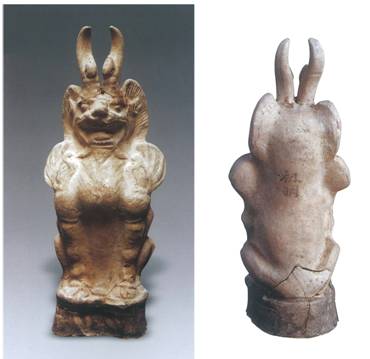
Fig.3
As described in The Book of the Later Han, zuming lived on the dismembered corpses of parasitic animals. The tiger-like beast unearthed from an Eastern Han tomb in the Mianxian County, Shaanxi Province, has a horn on the head and looks as if it is seeking food on the ground (Fig.4). Since a lion-faced tomb-guarding beast has been supposed to be zuming of the Tang Dynasty, this single-horn beast is likely to be the zuming as described in The Book of the Later Han. Nonetheless, further archaeological evidence is required.
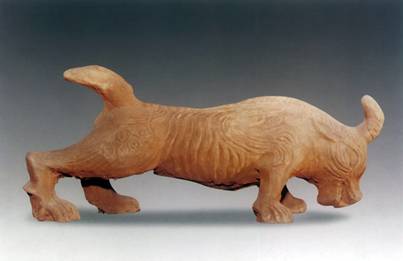
Fig.4
Dating back to the Spring and Autumn Period and the Warring States Period, tomb-guarding beasts were mainly in three types, namely human-faced ones in the Central Plains, tiger-faced ones in Hebei area and deer-antlered ones in the Chu area. However, there were no terminologies for those tomb-guarding beasts in historical records, maybe because they looked completely realistic. The ones in the Chu area were more or less of some imaginary sense. Many experts believed that those tomb-guarding beasts may be the ones described in historical records as “shanshen”, “tubo”, “menshen” and “fenyang”. No matter what they were called, the Chu-style tomb-guarding beasts disappeared in the late Warring States Period, while human-faced and tiger-faced ones remained in use as burial objects. That may be attributed to the position as the political and cultural center of China remained in the north.
The staff from Zhengzhou Municipal Research Institute of Cultural Relics and Archaeology launched an excavation project in July 2007 in a tomb of the Tang Dynasty in the Zhitian Town, Gongyi, Henan Province, yielded 70-plus cultural relics, of which this pair of imposing, gorgeous, and richly-decorated tomb-guarding beasts are particularly eye-catching.
1. The lion-faced tomb-guarding beast crouches high on a pedestal, the front legs straight. It has two curved horns on the head, a pearl inlaid in the forehead and a halberd extending behind the head. Its long mane looks like planks and its wings are moon-shaped. The lion-faced beast looks ferocious with bushy eyebrows, bulging eyes, a wide nose and an opening mouth. We may still discern its old-day beauty from the gold-foil and color-painted cloud patterns on its chest, despite the peeled off black, rust, blue, green, orange and pink paints on its body (Fig.1).
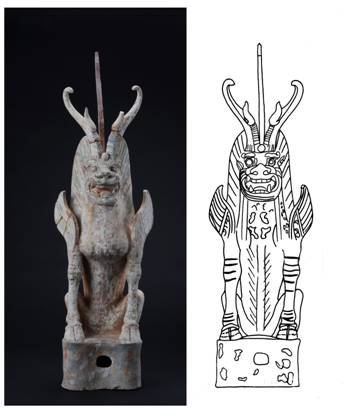
Fig.1 Lion-faced tomb-guarding beast and its line-drawing
2. The human-faced tomb-guarding beast crouches high on a pedestal, the front legs straight. The square-jaw beast has a pair of prominent jug ears and a flat curved horn. On the back of its head, there extends out a halberd-shape ornament. Two wings grow out of its shoulders. Simply painted, the beast also has gold-foil and cloud patterns on the chest, with the vestige of orange, black, rust and pink paints. This sad-faced beast has eyebrows knitted, thus is melancholy-looking (Fig.2).
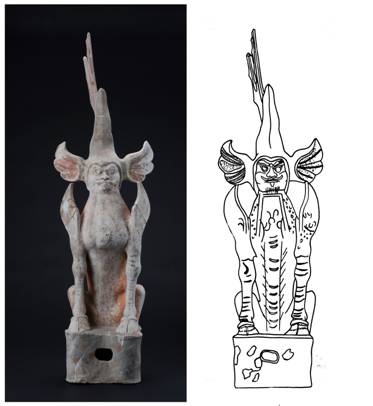
Fig.1 Human-faced tomb-guarding beast and its line-drawing
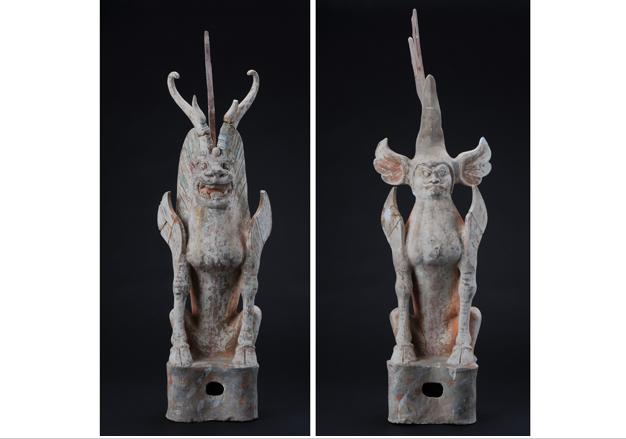
The paired tomb-guarding beasts with traces of pigment of the Tang Dynasty, measuring 76.4cm and 82.4cm high, respectively, were unearthed in 2007 in the Zhitian Town, Gongyi, Henan Province, and they are housed by Zhengzhou Provincial Cultural Relics and Archaeology Research Institute.